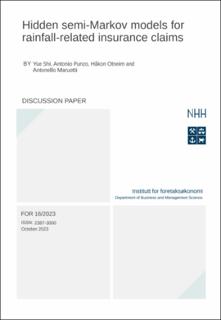| dc.description.abstract | We analyze the temporal structure of a novel insurance dataset about home insurance claims related to rainfall-induced damage in Norway, and employ a hidden semi-Markov model to capture the non-Gaussian nature and temporal dynamics of these claims. By exploring a wide range of candidate distributions and evaluating their goodness-of-fit as well as commonly used risk measures, we identify a suitable model for effectively modeling insurance losses stemming from rainfall-related incidents. Our findings highlight the importance of considering the temporal aspects of weather-related insurance claims and demonstrate that the proposed hidden semi-Markov model adeptly captures this feature. Moreover, the model estimates reveal a concerning trend: the risks associated with heavy rain in the context of home insurance have exhibited an upward trajectory between 2004 and 2020, aligning with the evidence of a changing climate. This insight has significant implications for insurance companies, providing them with valuable information for accurate and robust modeling in the face of climate uncertainties. By shedding light on the evolving risks related to heavy rain and their impact on home insurance, our study offers essential insights for insurance companies to adapt their strategies and effectively manage these emerging challenges. It underscores the necessity of incorporating climate change considerations into insurance models and emphasizes the importance of continuously monitoring and reassessing risk levels associated with rainfall-induced damage. Ultimately, our research contributes to the broader understanding of climate risk in the insurance industry and supports the development of resilient and sustainable insurance practices. | en_US |
